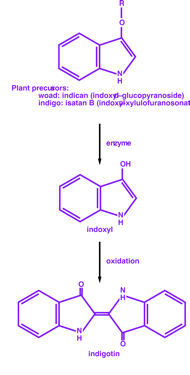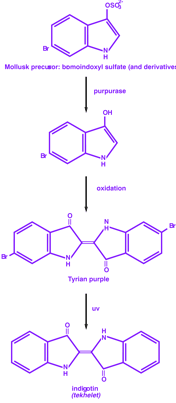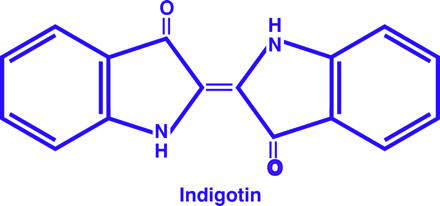The Mutability of Blue

A chemical structure projects an air of certainty. Its bold, efficient shorthand is a reification of our understanding and
control over the world, and of the immutability of form. When Baeyer (1)synthesized the coloring matter provided by woad, he marked a closure in the long history and prehistory of this plant dye.
On invading Britain in 55 bc, the Roman legions were allegedly confronted by warriors decorated with blue body paint prepared from dyer's woad (Isatis tinctoria), a cruciferous plant (i.e., of the cabbage family) known since Neolithic times. The plant is not indigenous to the British Isles, but rather is native to southern Europe. Woad has now spread even further afield, and has become a serious nuisance in parts of the United States.
The coloring agent derived from woad is indigotin. The plant itself contains no blue pigment; rather, a precursor, isatan B, is converted through a process of enzymatic hydrolysis and oxidation to the actual dye. Sources of indigotin extend far beyond dyer's woad; Schweppe lists approximately thirty-four species, distributed around the world (2).
The word indigotin derives from the Indian source of the blue dye, known to the Greeks as indikos and to the Romans as indicum. The Indian preparation, obtained from the plant Indigofera tinctoria (of the pea family), was described by Marco Polo. He explained how the leaves were placed in tubs of water and allowed to rot and then dry. Although the dye obtained from both woad (Isatis tinctoria) and indigo (Indigofera tinctoria) is chemically identical, the colorless precursors in the plants differ. In indigo, the precursor is indican (indoxyl-ß-d-glucopyranoside), a glycoside. The rotting or fermentation process described by Marco Polo hydrolyzes the glycoside to yield indoxyl, and the sun and air oxidation complete the conversion to indigotin.
Indigo has a thirtyfold higher pigment precursor content than does woad, and is thus a superior source of indigotin. Importation of indigotin from indigo killed off the woad industry in Europe, and in turn natural indigotin was displaced by cheaper, synthetic indigotin. At its height, however, indigotin production in India was a major industry, 9.5 million kilograms being produced from 1896 to 1897. In 1897, the German company BASF began marketing synthetic indigotin and exported 0.5 million kilograms. By 1913, the exportation rate had risen to 33.4 million kilograms per year. Conversely, annual exports of natural indigotin from India fell from 8.6 to 0.5 million kilograms over the same period (2).
A third historical occurrence of blue dye is the tekhelet of the ancient Israelites. In the Old Testament (Num. 15:37–39), Moses commands the Israelites to put fringes on their garments and that they “put upon the fringe of the border a ribband of blue…that ye may look upon it, and remember all the commandments of the Lord. ” “Blue” is a translation of the Hebrew tekhelet. This word shows up in other places. The Talmud, for example, mandates that the creed (i.e., the Shema) be recited in the morning when one can distinguish between tekhelet and white (3), a distinction that recalls the designation of the vesper hour as occurring “between the dog and the wolf.”
Based upon the translation of tekhelet as “blue,” the wearing of blue thread has assumed cultural and religious significance in Judaism, but considerable research and effort have gone into determining what the Biblical blue actually was: its source, how it was made, and its precise color. One Jewish scholar has concluded that “tekhelet resembles the sea, and the sea resembles the sky, and the sky resembles God's holy throne.” Others have considered, therefore, that tekhelet was literally sea blue in color. Those familiar with Homer's “wine-dark sea” might be more cautious in assuming that the color the ancients saw in Mediterranean waters is the same one we see.
A major difficulty with accepting tekhelet as merely “blue” was its relationship to the Tyrian purple, or Imperial purple, of the Roman emperors. Both dyes were obtained from marine mollusks such as Murex by a procedure that predates the Greeks in the Mediterranean. Tyrian purple, like tekhelet, is obtained from the hypobranchial gland of the snail, a mucus-secreting layer of glandular epithelium. A whitish fluid is obtained from the gland, which, under the influence of glandular enzymes, oxygen, and sunlight, changes color sequentially to yellow, green, blue, purple, and violet red. As the initial hydrolytic step is enzyme-mediated (by “purpurase”), the hypobranchial fluid must be obtained from live or recently killed mollusks. Tyrian purple was so highly regarded that under a decree of Nero (first century ad), only the emperor could wear clothing dyed with it.

The actual color of Tyrian purple has also been debated over time, the proposed tints ranging from violet to deep red and brownish red (4). Pliny the Elder, in one of his rare happy phrases, thought the best Tyrian purple was “the color of clotted blood, dark by reflected, and brilliant by transmitted, light.” Argument was muted when Friedländer obtained 1.4 grams of a deep purple compound, which he identified as 6,6'-dibromoindigo, from 12,000 mollusk organisms (Murex brandaris) in 1909 (5). He also noted a blue dye in addition to dibromoindigo.
Murex trunculus, found in massive piles near the ancient dye-producing areas of Tyre, is now accepted as a source of both Tyrian purple and Biblical blue. But if the color of Tyrian purple is largely due to dibromoindigo, how can tekhelet, coming from the same, or a similar, molluscan source, be blue? The color of tekhelet was debated for most of the twentieth century (6). Ziderman (7) went so far as to accuse translators of the King James Bible of erroneously translating as “blue” a color that was, he claimed, violet. The translation, however, is correct, and the disparity among the historical descriptions of color is illuminated by photochemistry. As Otto Elsner and Ehud Spanier have noted (6), wool dyed on cloudy days tended to be purple, but on sunny days turned out a pure blue. This difference was due to the photochemical reduction of purple dibromoindigo to blue indigotin. Thus, the blue of the tekhelet is chemically identical to the blue of woad and indigo. Starting from different sources in different cultures, we arrive at the same dye.
Interestingly, classical writers had also recognized the color variability in the natural dyes. Vitruvius writes in the first century ad, “Purple exceeds all colors in costliness and superiority of its delightful effect. It is obtained from a marine shellfish.…It has not the same shade in all the places where it is found, but is naturally qualified by the course of the sun” (8). The photochemical significance of Vitruvius' observation appears to have been overlooked. Vitruvius further discusses the production of black, blue, violet, and red hues.
The story of indigotin does not end with this tale of a pea, a snail, and a cabbage. Humans can also produce indigo blue, albeit only in pathological states. King George III of England, for example, was subject to acute, intermittent porphyria. On at least two occasions during episodes of illness, in which he was temporarily insane, his physicians noted that he produced blue urine. To be more precise, a ring of insoluble blue pigment was formed near the upper surface of the urine in the chamber pot. The king was badly constipated at the time, a characteristic of acute intermittent porphyria. Arnold (9) has convincingly demonstrated that the King's blue was indigotin: Fecal impaction in the bowel leads to bacterial breakdown of tryptophan to indole. Indole is absorbed and converted in the liver to indoxyl and indoxyl sulfate. In the urine, the latter is hydrolyzed back to indoxyl by bacterial sulfatases. Indoxyl undergoes oxidation at the surface of the urine to yield indigotin. Indeed, healthy adults excrete up to 140 milligrams of indoxyl sulfate per day, enough to produce a smidgen of indigotin, under the right conditions. However, unemptied chamber pots have largely disappeared from modern life.
As Homer's “wine dark sea” suggests, interpreting the precise shade being indicated in the literature of other times and cultures can be difficult. Indeed, numerous suggestions have been advanced to account for Homer's choice of adjective. The hypotheses range from an early twentieth-century theory that Greek eyes had not evolved sufficiently to perceive many color differences, to the supposition of episodes of Red Tide in the Mediterranean when Homer was writing, to the claim that Greek wine was black or blue-black rather than red, to hair-splitting along the lines that “wine-dark” is not the same as “wine-colored.”
Color perception appears to be culturally determined. What would the ancient Greeks have made of an English aristocrat being described as “blue-blooded”? They would probably be as puzzled as we are by Aeschylus' reference to the purple blood gushing forth when Clytemnestra kills her husband, Agamemnon. Think of the way skin color in the modern world can be described as “black” or “white,” and think how puzzled an intelligent spectrometer would be by such usage. A pink-skinned northern European or a deep brown beach-loving Californian could both be described as “white,” whereas someone of a faint chocolate tinge could describe himself as “black.” Obviously, such usages include associations other than spectroscopic color. Presumably, all cultures have or had equivalent kinds of associations, even if we are unaware of them.
In addition, color words can change meaning from one age to another. What one century means by “blue” is not necessarily the same as another century means. The word “blue” derives from the same root as the Latin “flavus”, which is normally translated as yellow. “Blue,” indeed, probably derives from the inferred Indo-European root, “bhel”, from which a wide range of color terms have descended, including bright, brunette, burnt, blanche, blond, blush, and black (10). Language is an organic entity, and as such undergoes continual change. The meanings of words, like Wegener's tectonic plates, can drift. Color words seem especially prone to migration, reflecting perhaps that color perception is just that—a phenomenon of the brain modified by culture and experience. Different cultures apparently can differ in the number of colors recognized.
Chemistry can thus give a misleading certitude about the color obtained in dyeing with natural materials that ignores the linguistic changes. In at least one species of shellfish, the dye varies with sex, the male producing primarily indigotin and the female dibromoindigo. The presence of other compounds can modify the hue obtained. Thus, natural indigo contains between two and four percent of indigo red (indirubin), for example, plus various flavanoids derived from kaempferol. Other factors affecting hue include climatic conditions, plant age, season, and the plant tissues used.
Words change, we change, the world changes—the modern technicolor world, with ads swimming in synthetic dyes and coruscating TV screens, is a very different world from Europe of even a hundred years ago. It is not surprising if our color sensibilities differ from those who wrote of the purple sea and the tekhelet.

A chemical structure projects an air of certainty. Its bold, efficient shorthand is a reification of our understanding and
control over the world, and of the immutability of form. When Baeyer (1)synthesized the coloring matter provided by woad, he marked a closure in the long history and prehistory of this plant dye.
- © American Society for Pharmacology and Experimental Theraputics 2001





